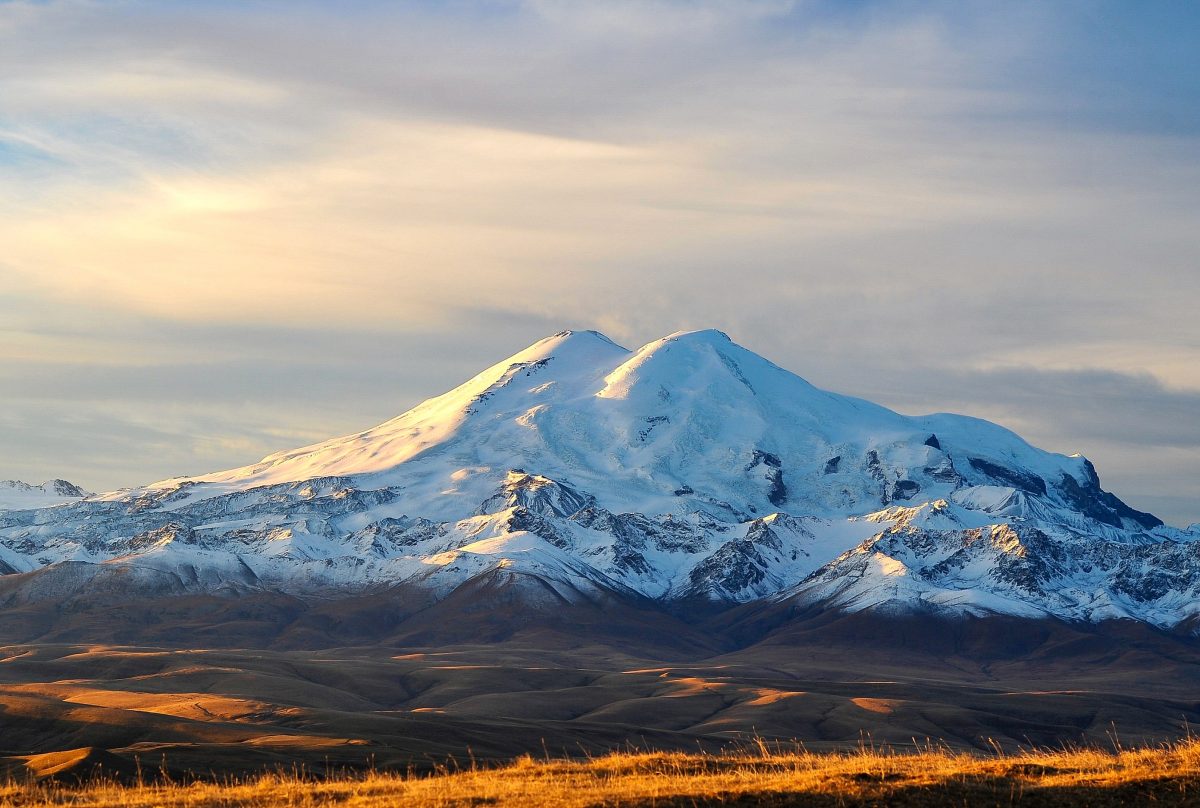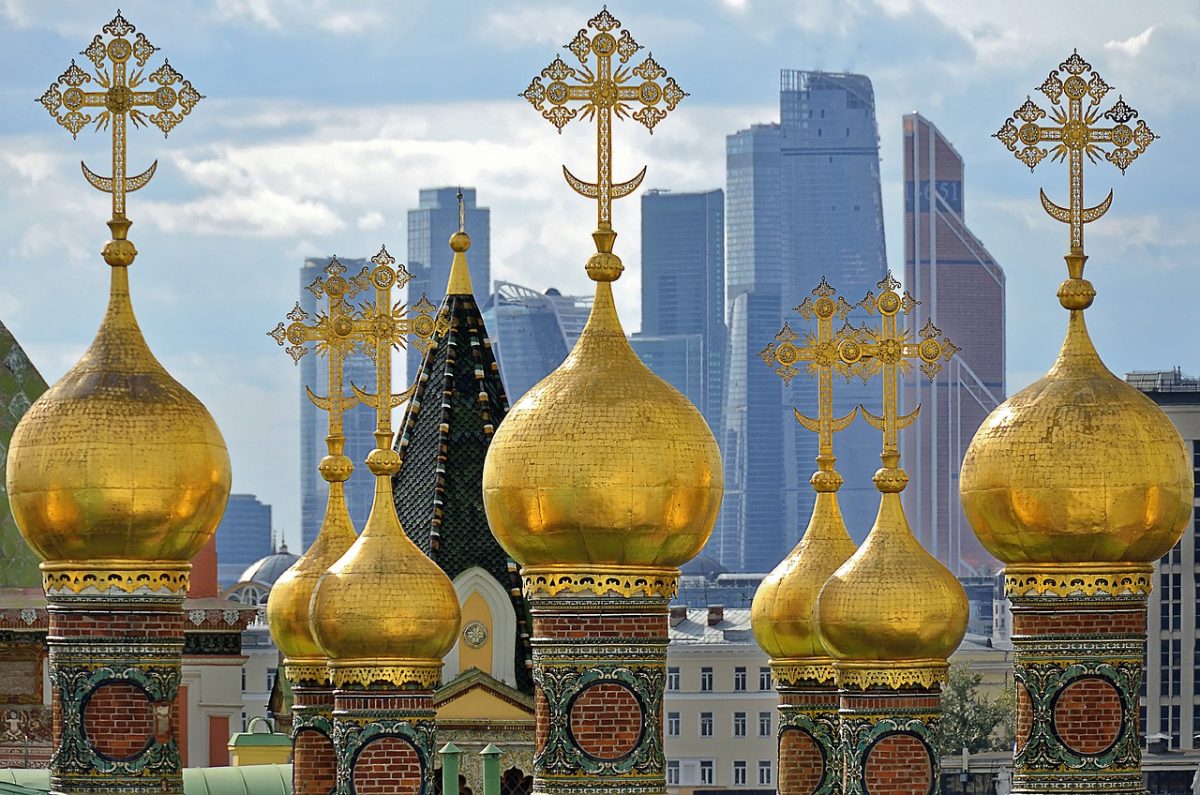Mount Elbrus – the highest mountain of the Caucasus Mountains ridge, occupies an important place in the Great Caucasus system. Geologists have come up to the conclusion that Elbrus is the cone of a dormant volcano. Its western peak reaches a height of 5642 meters, whereas the Eastern peak — is 5621 meters. They are separated by a deep saddle, reaching a five-thousand-meter height and 5325 m.
This makes it the highest mountain in Europe and one of the Seven Summits, the highest peaks in each continent, and elite climbers aspire to summit all of them. Since Elbrus is very high, it is always covered with a cap of ice and firn, from which, on all sides, 54 glaciers are falling, the largest ones being the Big Azau, Irik, and Terskol.
Meaning of the name Elbrus
“Mingi-Tau” is the name given to Elbrus by the Balkars, the Turkic people of the Caucasus region. This translates to “resembling a thousand mountains” as a homage to the mountain’s size. Before the Balkars, the mountain was known as Sobilus, Latin for “pine cone” This is a variation of strobilus, meaning “a twisted object,” which is an apt description of the mountain’s summit.

The mountain also has a mythological history in Greek mythology. Zeus chained Prometheus to the mountain as punishment for stealing fire from Zeus and sharing it with mankind. The name also has Persian origins, a derivation of Harā Bərəzaitī, a mountain in Persian mythology.
Elbrus’ climate
The climate is most conducive to climbing in July and August when the weather is at its most stable. Even in the summer, nighttime temperatures average 18 F (minus 8 C). Temperatures above the snowline can fall as low as minus 22 F (minus 30 C) during the day during the winter.
Winter is the coldest in the western part. It lasts from October to April, above 6,562 feet (2,000 m). The mountain is inland and positioned between the Caspian Sea and the Black Sea. These two large bodies of water have an impact on wind and precipitation.
Climbing Elbrus
Attempts to conquer Mount Elbrus were made even back when mountains were a point of interest for alpinists only and not skiers and snowboarders. The first one to reach the Eastern mountaintop in 1829 was the Russian explorer, the Kabardian K. Khashirov, who led the scientific expedition. In contrast, the Western top was conquered in 1874 by the English athletes led by F. Grove and the Kabardian explorer A. Sottaev, who was a member of the first Russian climbing expedition.
In Soviet times, climbing Elbrus was very popular. The ascensions turned into massive «alpinists». One of the biggest ones, which took place in 1967, had an attendance of no more no less than 2400 climbers. At the altitude of 4600-4700 meters are located the Pastukov’s Rocks of the Russian military topographer, who was the first to conquer both – the Eastern and the Western summits of mount Elbrus.

During the wintertime, an ice field stretches above these cliffs. At the 5000 m height begins the “oblique shelf”, so called by the alpinists, gently sloping, reaching a flat surface, and climbing to the top. Traditionally, the climbing route to any of Elbrus’s summits passes through its saddle. From there, the two peaks remain about 300 meters.
The infrastructure is poorly developed on the north side of the mountain massif. Just a few huts for climbers are used by tourists and employees of MChS (Ministry of Emergency Situations). As a rule, from the north side take place only climbs to the East top. The route passes through the Rocks of Lenz (from 4660 to 5200 m).
Skiing Elbrus
In Russia, the Elbrus region has always been one of the most famous winter sports and tourism centers. Mount Cheget is Elbrus’s most visited slope, which is well equipped with chairs and gondola lifts. The routes here are of different levels of difficulty.
Thus anyone, from beginners to experts, will find in Cheget a course on his ability level. In addition, Cheget has beautiful tourist entertainment options. Cafes, restaurants, and equipment rental shops are operating on the slopes. A fantastic view of the two-headed Elbrus opens from the mountain.
Elbrus campsites
Concerning Elbrus, with all its rigors and external inaccessibility, which seem to indicate that there is no human presence, it has a solid infrastructure. It focuses mainly on the southern slopes of the mountain range, where the cable car road is located, with a height of 3750 m. Here you will find the “Barrels” accommodation, which has more than a dozen six-bed insulated residential trailers and a kitchen.
This place serves as the starting point for today’s athletes climbing Elbrus. In addition, a new, more modern shelter called the “Leaprus” was opened in 2013. It accommodates 48 people, and it is located at the height of 3912 m. The highest altitude hotel in the Elbrus region is “Shelter eleven”, whose main building burned down in the 90s of the 20th century.

Today though, based on the former boiler house of the hotel, a new building was built. Besides, the shelter has a few 12-bed trailers and a kitchen. Moreover, the work of a diesel generator with electricity supply in the cabins is organized to run in the evenings.
To those who will find themselves at the foothills of Mount Elbrus during the summer, we recommend visiting the Valley of narzan, located close to Cheget, where narzan, the mineral water that we were used to seeing in bottles and cans, beats straight out of the ground in large quantities in forms of springs.
The saddle of Elbrus, a starting point for all climbers to whichever peak they sought to reach, long needed a shelter on its own because the higher the climbers rise, the harder it gets. Hence accommodation at an altitude of 5300 is essential. Works on the construction started back in 2007.
The housing will represent a hemisphere with a diameter of 6.7m, installed on a foundation. By 2009 the dome was completed, and the construction works started. Nowadays, it is waiting for its visitors.
Key points in Elbrus history
1829: Kabardinian Killar Khashirov, a guide for a Russian army scientific expedition, was the first to reach the east summit, which is the lower of the two summits.
1874: The higher west summit was ascended by Akhia Sottaiev, a Balkarian guide, who was working for a group that was led by Brit Florence Crauford Grove and included Englishmen Frederick Gardner and Horace Walker, and Swiss climber Peter Knubel.
1932: The first hut, called “Prijut 11,” was built at of 13,650 feet (4,160 m).
1942: During World War II, German forces had occupied all the territories north of the Baksan Valley and were gradually taking the mountain valleys in the Western Caucasus. Eventually a German Alpine division commandeered Priut 11. They retreated by early1943 and by mid-February Elbrus was back under Soviet control.
1956: A group of 400 climbers ascended the mountain to commemorate the 400th anniversary of Kabardino-Balkaria, the regional Soviet Republic.
1991: The outhouse at the Pruitt Hut — before it burned down a few years later — was named the world’s worst outhouse by Outside Magazine. While it gets a lot of use from climbers who drink a lot of water and take altitude medication, it doesn’t smell because it is completely frozen.
1997: Russian adventurer Alexander Abramov led an expedition that drove a modified Land Rover to the summit, making it the highest mountain climbed by a vehicle.
1998: A group of climbers started a fire while cooking and burned down Priut 11.






